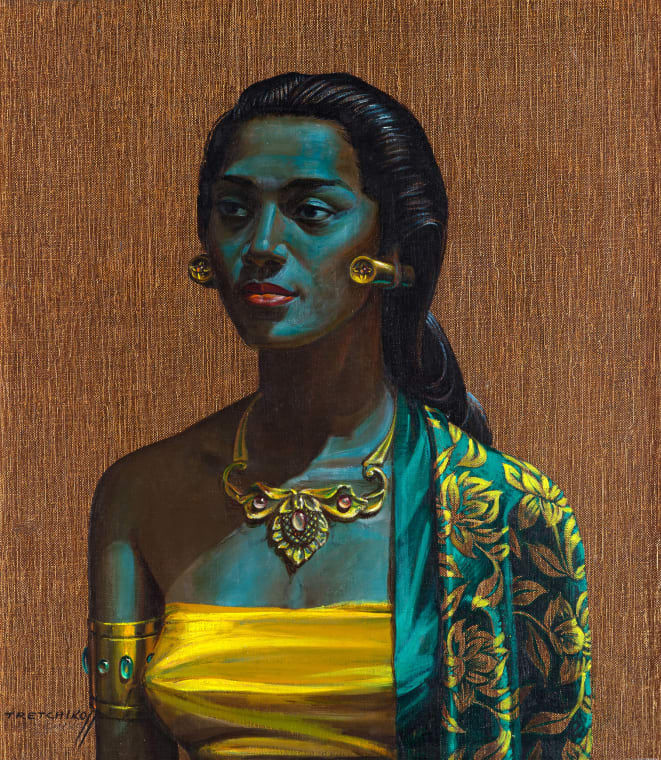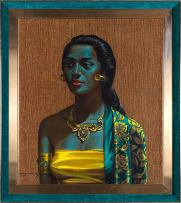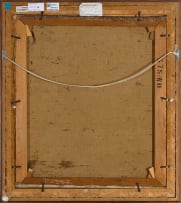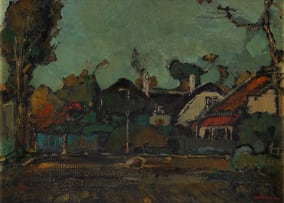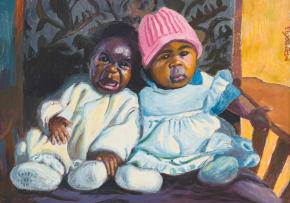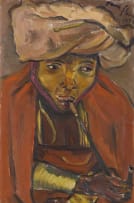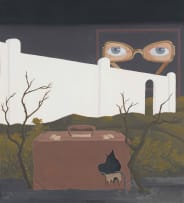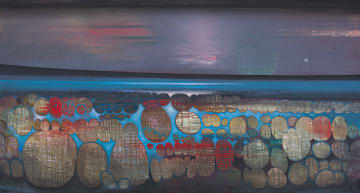Balinese Girl
Vladimir Tretchikoff
Incl. Buyer's Premium & VAT
About this Item
signed; inscribed with the title on the reverse; inscribed with the artist's name and the title on a South African National Gallery label adhered to the reverse
Provenance
Graham's Fine Art Auctioneers, Johannesburg, 19 May 2010, lot 78.
Private Collection.
Exhibited
South African National Gallery, Tretchikoff: The People's Painter, 26 May to 25 September 2011, illustrated in the exhibition catalogue on page 11, cat. no. 60.
Notes
Vladimir Tretchikoff's Balinese Girl represents a work by the artist at the height of his powers and from his classic period, which includes works such as Chinese Girl (1952), Miss Wong (1952-1953) and Lady from Orient (1955)1. These three works, along with the present lot, are amongst a handful of Tretchikoff's 'orientalist' pieces which epitomise the artist as a sensitive portrayer of women historically marginalised. In his writing about the works of this period, theorist Ashraf Jamal notes: 'The titles are reified, absolute, fuelled by a desire to create an equatorial ideal, a sense of the East as a zone of the sacred; its women as a font of the sacred.'2 It is an oversimplification to view a work such as Balinese Girl as a mere fantasy of the East; rather Tretchikoff is at pains to present his sitter in a dignified pose, proudly bearing the costume and jewellery of her home country and in all, suffused by the beauty and sparkle of glamour. This is at a time when such subjects were often the subject of gross caricature and misrepresentation.
As with all works of this period (and indeed later) Tretchikoff would have worked from a live model and this shows, I believe, in the sensitivity of the portrayal of the face and of the figure, her placidity yet self-confident gaze and the easy way she carries her costume. Her richly embroidered gown in turquoise-blue and gold is casually draped over her left shoulder revealing a bright canary-yellow dress beneath and her armband, necklace and earplug earrings of gold speak of nobility and grace. The entire portrait is in careful balance, with the colours of her adornments in harmony and painted in such a way that each emphasises the others. Significantly, Tretchikoff has left some portions of the gown unpainted, allowing the textured canvas background showing through. This is a technique straight out of the copybook for Chinese Girl and is a masterful demonstration of the artist's confidence in his craft.
The 'trademark' bluish-green colour of the figure's face is one that the artist reserved for only his most important portraits and sets this work apart as one of his masterworks. The seemingly startling use of this effect has a two-fold purpose: on one hand, it flies in the face of the absurdity of apartheid classification that Tretchikoff found in his adopted country, South Africa. (His work of 1959, Black and White - which had to be smuggled out of the country, makes this abundantly clear.) On the other hand, the colour, which should be one that estranges the subject, actually humanises her whilst also suffusing her with an air of mystery in the very essence of beauty.
The work is in its original frame, one that would have been chosen by the artist to complement the colours he has used. In terms of date, there is always the problem that Tretchikoff rarely dated his paintings during this period, but I would ascribe it to the period 1954-56, just after Chinese Girl, at a time when the artist, with supreme confidence, embarked on a small series of similar works, each suffused with the power of his most iconic period of painting.
Andrew Lamprecht, Curator of Historical Paintings and Sculpture at the Iziko South African National Gallery.
1. Boris Gorelik (2013) Incredible Tretchikoff: Life of an Artist and Adventurer, United Kingdom: Art Books Publishing Ltd, page 149 to 159.
2. Jamal, Ashraf (2011) 'Turning Eastward: Vladimir Tretchikoff's Orient' in Andrew Lamprecht (ed) Tretchikoff: The People's Painter, page 64.
Literature
Andrew Lamprecht (ed) (2011) Tretchikoff: The People's Painter, Johannesburg: Jonathan Ball Publisher (Pty) Ltd, illustrated in colour on page 60.
